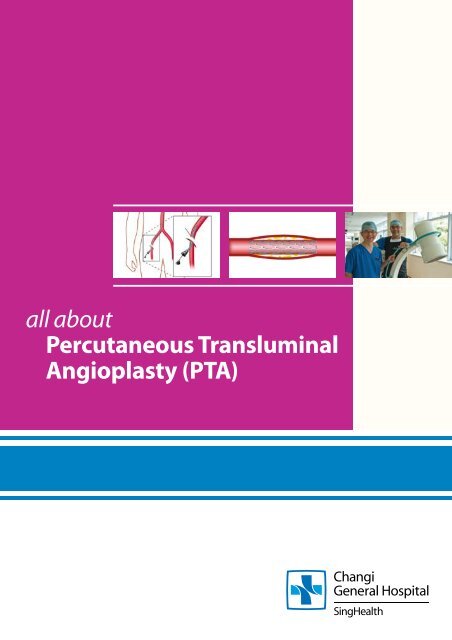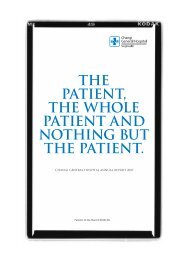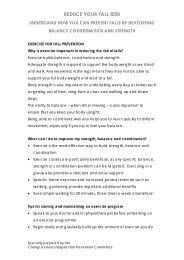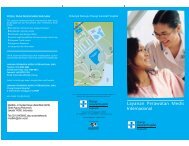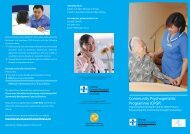all about Percutaneous Transluminal Angioplasty (PTA)
all about Percutaneous Transluminal Angioplasty (PTA)
all about Percutaneous Transluminal Angioplasty (PTA)
You also want an ePaper? Increase the reach of your titles
YUMPU automatically turns print PDFs into web optimized ePapers that Google loves.
<strong>all</strong> <strong>about</strong><br />
<strong>Percutaneous</strong> <strong>Transluminal</strong><br />
<strong>Angioplasty</strong> (<strong>PTA</strong>)
Treatment of narrowing of the leg or pelvic arteries<br />
under Fluoroscopy<br />
Investigations has shown that narrowing of blood<br />
vessels are the cause of circulatory problems in your<br />
legs or pelvic area.<br />
<strong>Percutaneous</strong> transluminal angioplasty (<strong>PTA</strong>)<br />
<strong>all</strong>ows the doctor to dilate narrowed or blocked<br />
blood vessels under X-ray and possibly keep them<br />
open with a stent. You will be informed <strong>about</strong> the<br />
procedure and possible risks and consequences of<br />
the proposed action and of alternative methods, so<br />
you can decide and agree to the treatment.<br />
Patients will undergo angioplasty here<br />
Your arteries are norm<strong>all</strong>y smooth and unobstructed on the inside, but as you<br />
age, plaque can build up in the w<strong>all</strong>s of your arteries. Cholesterol, calcium, and<br />
fibrous tissue make up this plaque. As more plaque builds up, your arteries can<br />
narrow and stiffen. This process is c<strong>all</strong>ed atherosclerosis, or hardening of the<br />
arteries. Eventu<strong>all</strong>y, enough plaque builds up to reduce blood flow through your<br />
arteries causing pain or damage to the part of the body that the artery supplies.<br />
Surgical Bypass is another alternative to angioplasty but requires an open<br />
operation under General Anaesthesia and longer hospital stay. Your Doctor will<br />
discuss the pros and cons of each and advise you accordingly.<br />
What happens during the procedure?<br />
Why do I have to undergo this procedure?<br />
Artery narrowed<br />
by plaque<br />
<strong>Angioplasty</strong> is often used to surgic<strong>all</strong>y<br />
repair damaged or diseased blood<br />
vessels.<br />
It is most often used to treat peripheral<br />
arterial disease (PAD), which is another<br />
name for hardening of the arteries<br />
supplying blood to your limbs or to organs<br />
in your body other than your heart.<br />
<strong>Angioplasty</strong> can also be used to treat<br />
narrowed areas in your veins, which are<br />
blood vessels that drain blood out of your<br />
limbs or organs and return the blood to<br />
your lungs and heart.<br />
Femoral<br />
artery<br />
Catheter<br />
insertion<br />
Before the insertion, the nurse will clean your skin<br />
and shave any hair in the immediate area. This is<br />
done to reduce your risk of infection. Your doctor<br />
numbs your skin with local anaesthesia and<br />
then makes a sm<strong>all</strong> cut or puncture to reach the<br />
artery below. Although you may be given some<br />
mild sedation, your doctor will usu<strong>all</strong>y want you<br />
to stay alert to follow instructions and describe<br />
your sensations during the procedure. The doctor<br />
then inserts a thin hollow needle into an artery<br />
or a vein in the groin, elbow, or in the armpit.<br />
Through this needle under X-ray, a wire followed<br />
by a very thin plastic tube (catheter) is advanced<br />
to the narrowed vessel. The doctor then injects a<br />
dye (contrast) into your arteries to visualise the<br />
blockage. This is c<strong>all</strong>ed an Angiogram.<br />
2 3
During this time, you may experience a brief<br />
warm sensation. This is normal. You should<br />
try to lie very still during the injection to<br />
prevent blurring of the pictures. During the<br />
test, we may ask you to hold your breath for<br />
<strong>about</strong> 5 to 15 seconds.<br />
Depending on circumstances, the following therapies can be used to open the<br />
blockage:<br />
• an inflatable b<strong>all</strong>oon to dilate the constriction (angioplasty)<br />
Under X-ray, a deflated b<strong>all</strong>oon is positioned across the narrowing or blockage.<br />
The b<strong>all</strong>oon is inflated to press the plaque against the vessel w<strong>all</strong> and this may<br />
last between 1 to 5 minutes. Occasion<strong>all</strong>y, this may be repeated. Your artery may<br />
stretch and your blood flow through the artery stops when the b<strong>all</strong>oon is pushing<br />
your artery open. This may cause pain. However, the pain should go away when<br />
your doctor deflates the b<strong>all</strong>oon and normal blood flow resumes. Do tell your<br />
doctor if you experience any symptoms during angioplasty.<br />
After angioplasty, your doctor will sometimes need to use a stent to brace the<br />
artery open to prevent re-occlusion (or closing).<br />
• a stent (an inert metal which is expanded to act like a scaffolding to keep the<br />
blood vessel wide open)<br />
• a cutting device to remove the artheroma or debris that is causing the<br />
blockage (arterectomy)<br />
• a rotary instrument to remove blood clots<br />
• a laser source to fragment the artheroma<br />
• ‘clot busters’ which are used to dissolve blood clots (thrombolysis)<br />
The most common therapy is <strong>Angioplasty</strong> with or without supplementary<br />
Stenting.<br />
Stent in place<br />
A stent is a tiny mesh tube that looks like a sm<strong>all</strong> spring, and comes in a variety of<br />
sizes. The stent remains in place to support the w<strong>all</strong>s of your artery. Your artery<br />
w<strong>all</strong>s grow over the stent, preventing it from moving. Although stents help prop<br />
open your arteries, scar tissue sometimes can eventu<strong>all</strong>y form around stents and<br />
cause restenosis or reblockage.<br />
A new type of stent is coated with drugs. These drugs may help prevent scar<br />
tissue from forming inside a stent. Studies have shown that these new stents<br />
may be more likely to prevent restenosis than ordinary, non-coated stents.<br />
During <strong>all</strong> these procedures, blood thinners will be used to prevent clots in your<br />
arteries/veins. Other medications may also be used to relax your blood vessels.<br />
B<strong>all</strong>oon opening artery<br />
4 5
What happens after the procedure?<br />
At the end of the procedure, dye is again injected through the catheter to see the<br />
results of the therapy. Further treatment during the same setting or at another<br />
time may be required to achieve a satisfactory result.<br />
A typical procedure norm<strong>all</strong>y lasts 1 to 2 hours. However, in complex cases, the<br />
procedure may stretch longer.<br />
At the end of the procedure, the doctor will remove the wires and b<strong>all</strong>oons from<br />
the injection site. He may do the following:<br />
• Apply a compress on the injection site for 10-15 minutes which may cause<br />
some discomfort. After compression, you must lie still in a flat bed for 6-24<br />
hours to prevent bleeding at the injection site.<br />
• He may use a device to artifici<strong>all</strong>y close the injection hole in the artery (closure<br />
device eg Angioseal, Proglide, Starclose) which will <strong>all</strong>ow you to move around<br />
after 2 hours.<br />
Usu<strong>all</strong>y, you need to stay in bed for 2 to 24 hours after your angioplasty depending<br />
whether a closure device was used. If your doctor inserted the catheters through<br />
an artery in your groin, you may have to hold your leg straight for a few hours.<br />
If your arm was used, then you will need to hold it still to minimise the risk of<br />
bleeding. During this time, you will be closely monitored for any complications<br />
by your doctor and nurses.<br />
If you notice any unusual symptoms after your procedure, you should tell your<br />
doctor or nurse immediately. These symptoms include fever, shortness of breath,<br />
leg or back pain that lingers or gets worse, an arm or a leg that turns blue or feels<br />
cold, and bleeding, swelling, pain or numbness around your injection site.<br />
After the procedure, you should drink plenty of water for 2 days to help flush<br />
the contrast dye out of your body. You can usu<strong>all</strong>y shower 24 hours after your<br />
procedure.<br />
Your doctor will prescribe aspirin or other medications that thin your blood. These<br />
medications will help prevent clots from forming on your stent. Your doctor will<br />
usu<strong>all</strong>y see you the next day to explain the results and make sure you have not<br />
developed any complications.<br />
It is important that you STOP SMOKING and take <strong>all</strong> your prescribed medications<br />
to prevent the blockages from reforming i.e. restenosis. This may happen very<br />
soon in some cases. Your doctor will advise you accordingly.<br />
You may be scheduled for more ultrasound scans after the procedure. This is to<br />
detect restenosis. Depending on circumstances, your doctor may recommend a<br />
repeat angioplasty.<br />
6 7
Are there complications?<br />
Severe complications arising from angioplasty are rare. However no medical<br />
intervention is entirely free of risks. Despite the utmost care, known medical<br />
complications may occur requiring immediate treatment and may even be lifethreatening.<br />
These include:<br />
• Pain and bruising at the puncture site, which are harmless and usu<strong>all</strong>y<br />
disappear on their own without treatment. Life threatening bleeding is<br />
uncommon but may require emergency surgery.<br />
• Rarely, one might experience <strong>all</strong>ergic reactions to the contrast agent, the<br />
local anesthetic or possibly medications, which may result in nausea, itching<br />
or skin rash. These usu<strong>all</strong>y resolve by themselves and require no treatment.<br />
Severe <strong>all</strong>ergic reactions with swelling in the windpipe causing respiratory<br />
problems, convulsions, or cardiac failure are rare. These will require intensive<br />
medical care and may cause permanent organ damage.<br />
• An uncommom worsening of your kidney function which is usu<strong>all</strong>y temporary<br />
but may be permanent and may even require dialysis. Diabetics and patients<br />
with pre-existing kidney problems are at a higher risk.<br />
The procedure is performed under fluoroscopy. The radiation dose is low so<br />
that even long or repeated treatment and the inevitable exposure of the genital<br />
organs are gener<strong>all</strong>y safe.<br />
In the case of pregnancy, there is a risk of injury to the unborn child through<br />
the X-rays. Please tell the medical staff if there is an existing or suspected<br />
pregnancy!<br />
• Rare blood infections which may require treatment with antibiotics and/or<br />
intensive care.<br />
• Rare bleeding or injury of the blood vessels through the catheter or other<br />
instruments which may require immediate vascular surgery.<br />
• Rare formation of blood clots or thrombosis in the treated vascular segment<br />
after therapy. This may be due to the detachment of plaques or pre-existing<br />
blood clots/fat particles, causing vascular occlusion (embolism) and require<br />
immediate intensive care or surgical treatment. This may result in stroke or<br />
a worsening of blood supply to the affected limb resulting in limb loss. This<br />
is particularly true in heavily pre-damaged vessels. Blood-thinning or blood<br />
dissolving drugs may help in these cases but may cause an increased risk of<br />
bleeding in the brain or intestines.<br />
8 9
Questions<br />
Ask-a-CGH Nurse Internet Service<br />
The risk of complications depends on your physical condition and any previous illnesses.<br />
Please help us assess your risk:<br />
1. Have you ever had a <strong>PTA</strong> performed? no yes<br />
2. If so, when, why and in what area of the body? Did you encounter problems?<br />
3. Do you have any <strong>all</strong>ergies? Allergic to foods? no yes<br />
Allergic to CT contrast injections?<br />
Changi General Hospital has an Ask-a-CGH Nurse Service on our Internet website.<br />
This service is an additional avenue for you to ask questions <strong>about</strong> health-related<br />
concerns. The service is provided by our team of experienced nurses, in consultation with<br />
our medical specialists and paramedical staff. This service is not intended to substitute<br />
medical advice or consultation.<br />
To use this service, go to our website at http://www.cgh.com.sg and click “Ask-a-CGH<br />
Nurse” to submit your question. You will hear from us within three working days.<br />
4. Have you ever had Vascular Surgery? Briefly when and what? no yes<br />
5. Do you have Diabetes? no yes<br />
6. Do you have any kidney problems? no yes<br />
7. Do you have a bleeding problem or blood clotting problem? no yes<br />
8. Are you on blood thinners eg Warfarin/Coumarin? no yes<br />
9. Is there a chance you may be pregnant? no yes<br />
Your doctor will person<strong>all</strong>y take the consent for the procedure from you and address any<br />
other concerns you may have.<br />
I have read the above and have answered the questions to the best of my abilities.<br />
Interactive Patient Guide www.cgh.com.sg/ipg<br />
CGH is pleased to introduce the Interactive Patient Guide (IPG) – Singapore’s first online<br />
interactive health education system.<br />
Developed by our team of clinical specialists, IPG provides an exciting multimedia<br />
alternative to health-related information.<br />
IPG features a list of common medical conditions, treatments, procedures, post<br />
procedures and aftercare through videos and printable text.<br />
The video clips <strong>all</strong>ow you to see exactly how a procedure is carried out or details of a<br />
health condition. For greater convenience, print-friendly versions are also available so<br />
that you can print and read at your own pace.<br />
With IPG on the Internet, you can explore it anytime you want, in the comfort of your<br />
own home and even share it with your family and friends.<br />
Log on today!<br />
Interactive Patient Guide www.cgh.com.sg/ipg<br />
Name<br />
Signature & Date<br />
10 11
For appointments and enquiries,<br />
please c<strong>all</strong> the CGH Appointment Centre at<br />
Tel: (65) 6850 3333<br />
CGH Appointment Centre operating hours:<br />
8.30 am to 8.00 pm (Monday to Friday)<br />
8.30 am to 12.30 pm (Saturday & Sunday)<br />
Closed on Public Holidays<br />
For more information, please visit<br />
http://www.cgh.com.sg<br />
2 Simei Street 3 Singapore 529889<br />
Tel: 6788 8833 Fax: 6788 0933 www.cgh.com.sg<br />
Reg No 198904226R<br />
All information is valid at the time of printing (September 2010)<br />
and subject to revision without prior notice.<br />
Organisation Accredited by<br />
Joint Commission International


